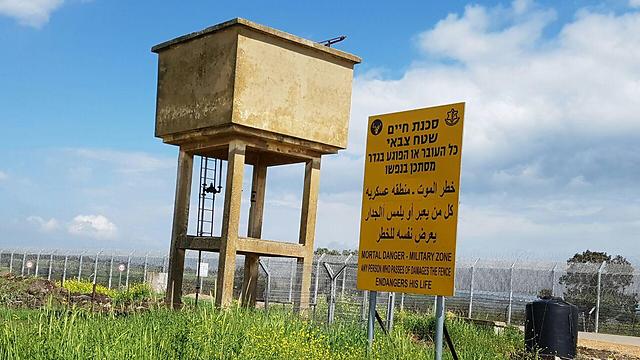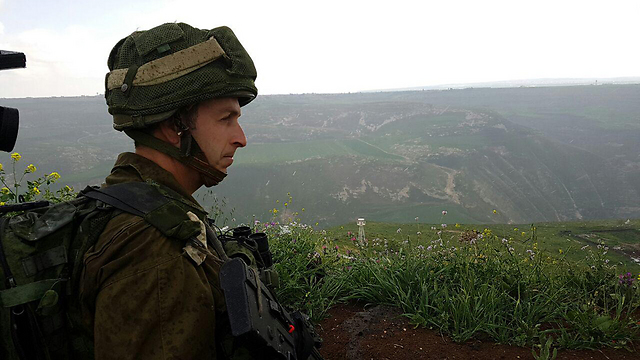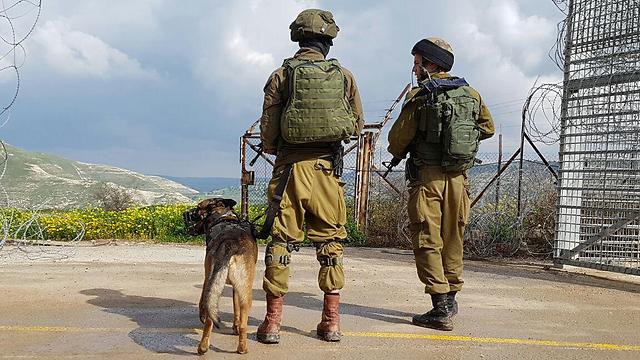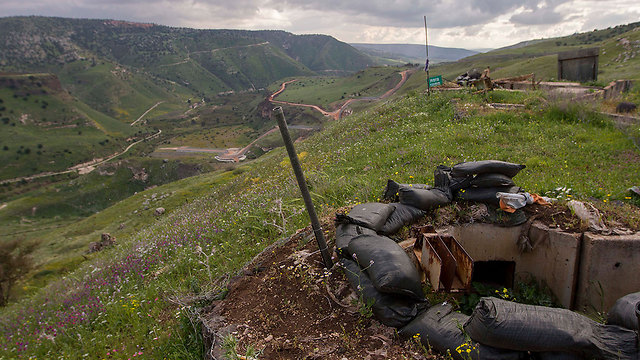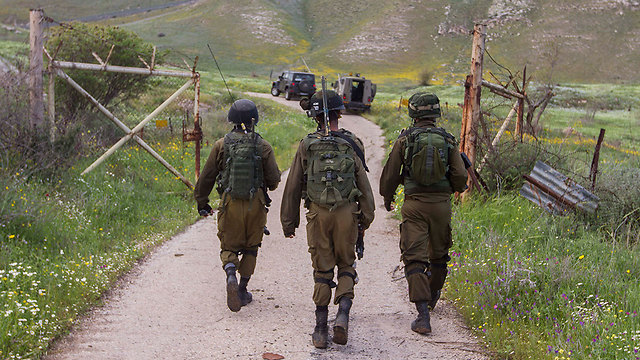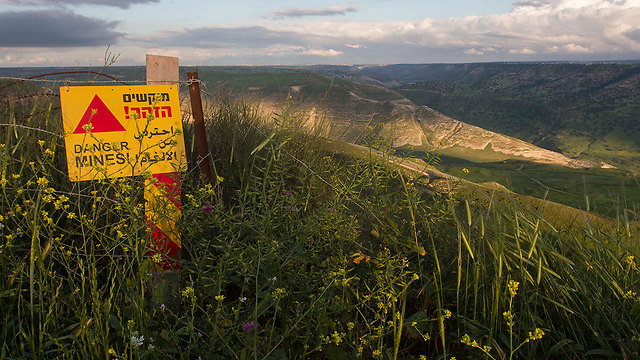
Crossing into ‘ISIS land’ with Givati fighters
As children bathe in a natural pool on the Israeli side of the southern Golan Heights, an Islamic State fighter teaches Syrian kids on the other side how to fire an assault rifle. Ynet’s correspondent joins a Givati patrol unit as it crosses the fence in the most dangerous and explosive region, where the IDF is preparing for the possible infiltration of dozens of ISIS terrorists.
On the other side of the border, as the Israeli children bathe undisturbed in a hidden jewel of nature, a Syrian boy from the nearby village of al-Sharaf learns how to fire an assault rifle, guided by an Islamic State member, in an improvised shooting range between an abandoned United Nations post and the slopes of the Ruqqad River.
“Everything here is green, people hike here and enjoy the nature and the amazing landscape, and only several kilometers away there is total chaos,” says Lieutenant Colonel Nir Ben Hamo, commander of the Givati patrol unit, who has been responsible for this area in the past few months. The same view—from two different worlds.
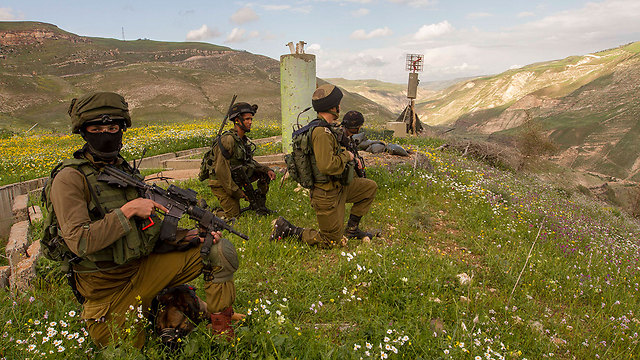
While the heart of Ben Hamo’s regiment belongs in the south, keeping one eye on Gaza at all times, and his forces are constantly preparing for war in Givati’s home zone, for several months in the past year Lt. Col. Ben Hamo and his soldiers were in charge of the most dangerous and explosive region, where they had complete lack of control and limited intelligence on the enemies. This time, it was neither the familiar Hamas nor Hezbollah, which remains the army’s primary scenario, or even 1,000 ISIS fighters scattered across a huge area in Sinai, who the Egyptian army is working to crush.
Only last week, Arab media reported on an attack—likely the first of its kind—of ISIS posts on the Syria-Israel-Jordan border, which was most probably carried out by the international coalition’s aerial forces. According to foreign sources, Israel has been helping the forces that are fighting ISIS in Syria and Iraq for years, providing intelligence on targets, and it’s quite possible that it did the same this time too. Nevertheless, the explosive tensions and the incomprehensible discrepancy between the pastoral view and the moment that everything could blow up continue as the forces move northward along the border fence.
Israel is not taking in Syrian refugees yet, but they are already knocking on its door. In the past year, refugee encampments have been slowly piling up near and north of Har Chozek, close to the orchards of the Druze town of Buq'ata, a few tens of meters from the fence. The IDF has also institutionalized the handling of wounded Syrians: The field hospital in the northern Golan Heights has been shut down, and military teams have been trained to provide quick care on the ground and examine every wounded person in an armed and secured booth on the fence, before evacuating them into Israel.
The fighters along the border not only hear the sounds of explosions and bursts of gunfire, but they also read press reports sometimes about alleged Israeli attacks and targeted killings of Hezbollah and regime supporters who are active in the Syrian Golan Heights. “These incidents definitely prompt us to raise the alertness and tension level among the fighters, out of a common sense that the Syrian regime may react against us,” explains Lt. Col. Gidi Kfir-El, commander of the 9th Battalion of the 401st Armored Brigade, who is responsible for the central and northern Golan Heights area.
“The perception of our activity in the defense mission,” he adds, “has become just like our activity vis-à-vis the Gaza Strip: Regimental combat teams of the engineering, armored, infantry and canine forces, with combat intelligence gathering and aerial guidance if necessary. We are capable of getting a tank ready for action within minutes, and like in Gaza, it has possible targets beforehand for a counter-attack over a spillover from Syrian fighting.”
The problem with ISIS in the Golan Heights is that it is largely based on locals—a few thousand ISIS-supporting residents in villages in the southern Golan, who are trying to increasingly wear out the Al-Nusra Front organization, al-Qaeda’s branch in Syria, which is considered more moderate and which still controls a considerable part of the border strip with Israel. In between, there are a number of small outposts which still belong to the army of Syrian President Bashar Assad, who recently fought back and succeeded in regaining control of a few parts of the northern Golan Heights. The southern part remains black, painted in ISIS colors.
“It is for a reason that the IDF constantly stations the regular reconnaissance units here, the finest units with specific patrol, antitank and destruction abilities,” says Lt. Col. Ben Hamo, who during Operation Protective Edge replaced his commander, Major Benaya Sarel, who was killed near Rafah while chasing the kidnappers of Lt. Hadar Goldin. Ben Hamo asks his fighters to exercise quite a lot of restraint and intelligence against the enemy.
“In a regimental or even company region,” he says, “there could be a few rules of engagement, sometimes for the same fighters, in accordance with the type of gunmen they see. In this region, we get to exercise our specific abilities excellently. We see members of Shuhada al-Yarmouk (the ISIS organization’s name in the Syrian Golan Heights) attacking more areas controlled by the other rebels. They have diverse weapons, Western arms, antitank missiles, explosive devices and even some armored vehicles, including a few tanks.”
Lt. Col. Ben Hamo prefers to hold his peace when he is asked if wounded Syrians are offered humanitarian aid in his region as well. Up until recently, Israel took a lot of pride in this activity, but then it apparently decided to keep a low profile for some reason. The field hospital that was built on the border in the northern Golan Heights halted its activity, the official reason being an optimization of the way the wounded are evacuated to Israel. In the southern part of the Golan Heights, which is controlled by ISIS, the IDF prefers to keep mum on the humanitarian issue.
The IDF refers to the Syrians who live in the Golan Heights as “locals,” and has detected that they prefer to keep the war as far away from their villages as possible. Nevertheless, the army does not approve of the southern villagers’ support for ISIS, which was implemented about nine months ago when mortars and gunshots were fired at a Golani force that was in the middle of conducting an ambush operation as it crossed the fence while remaining in an Israeli enclave in the southern Golan Heights. There were no casualties among the soldiers, but the IDF launched a quick response: Tanks and aircraft killed the cell members and destroyed a United Nations Disengagement Observer Force post, which was used by the Shuhada fighters.
When First Lt. Gal Yaniv, deputy commander of the armored company from the 9th Battalion of the 401st Armored Brigade, which operates in the region together with Givati, talks about “the incident,” he isn’t referring to the Golani incident or to previous incidents that took place on the border. He is addressing an incident which has yet to happen: The infiltration of a cell of dozens of ISIS terrorists through blind spots. It’s only a matter of time before this happens, he believes. “Within minutes, we are ready to bring a strong fire into this incident, even if it arrives without any intelligence warning,” the officer says as he directs Merkava Mk 4 tanks with Trophy active protection systems.
In Gal’s battalion, the fighters are versatile: Some perform infantry missions like ambushes and patrols near the fence, while their fellow fighters cover from back posts with the armored monsters, hidden from ISIS antitank cells. “Tanks have already attacked posts in retaliation fire, including in the recent incident with the Golani patrol unit, but we are ready and prepared for a shelling of other targets in another incident, ‘the incident,’ with the same tanks, in an evolving incident,” the young officer explains.
The Givati patrol unit’s commander speaks calmly, practically whispering, as we cross the intimidating fence that has been built along the entire border strip, from Hamat Gader to the foot of Mount Hermon. He points to the next “Hourglass Project” in his region: A considerable upgrade of the barrier in the border triangle, facing the Jordanian side as well, which is also concerned by the ISIS spillover to the south, into its territory. “The new barrier there will do a better job explaining exactly where the border passes to whoever needs an explanation,” the battalion commander indicates.
Scouts, fighters from the Oketz canine unit and observation devices open up the area for us. On the surface, there is no more barrier to separate us from dozens of ISIS gunmen in the village of Abadin, which is located about 2 or 3 kilometers away, on the eastern bank of the Ruqqad River. In front of us, down the mountain extension, we see the sooty remains of an ISIS post that was bombed by the IDF in an encounter with Golani.
“ISIS fighters are training in the constructed area and eastward in the open area, sometimes in improvised firing ranges too,” Lt. Col. Ben Hamo explains. “They have headquarters which rise and fall, and fighters who come from the outside. Our job is to create a barrier between them and the farmers here, who keep working the land to the very last inch, as well as the many hikers and Golan Heights residents.”











